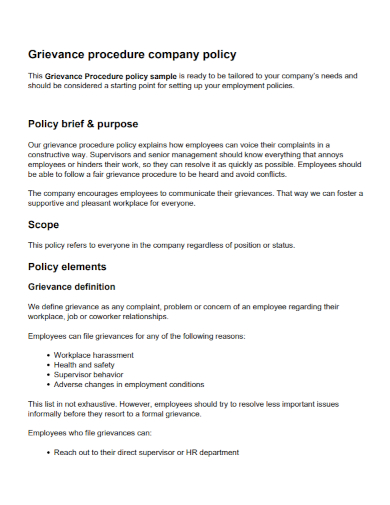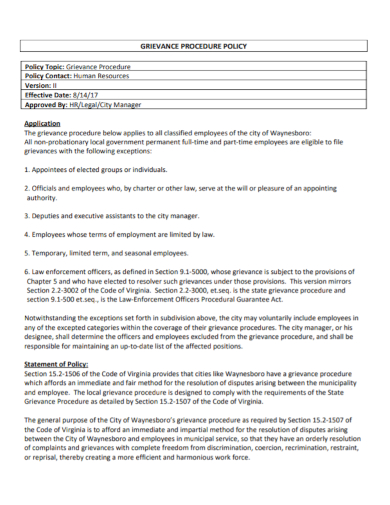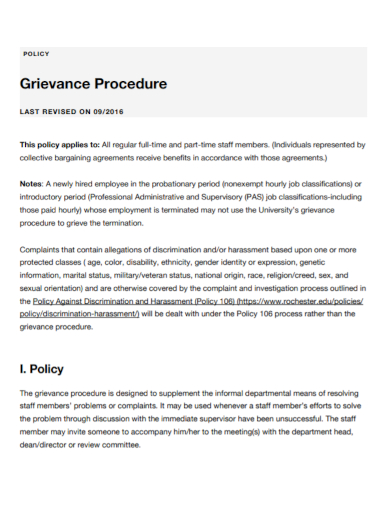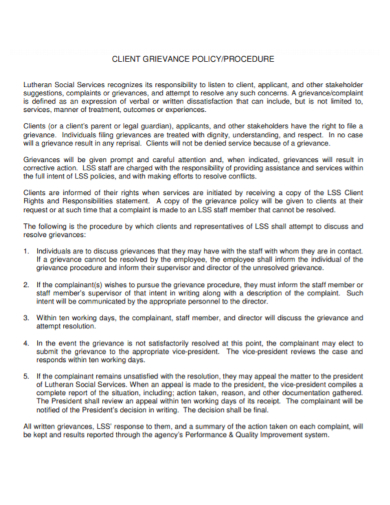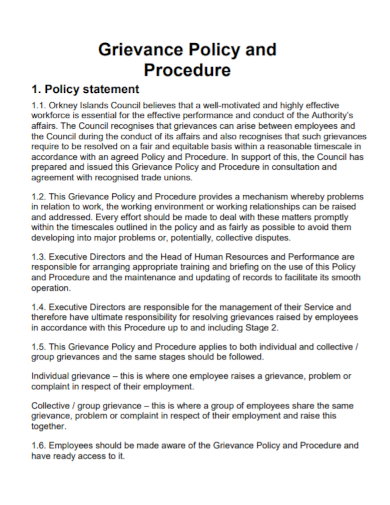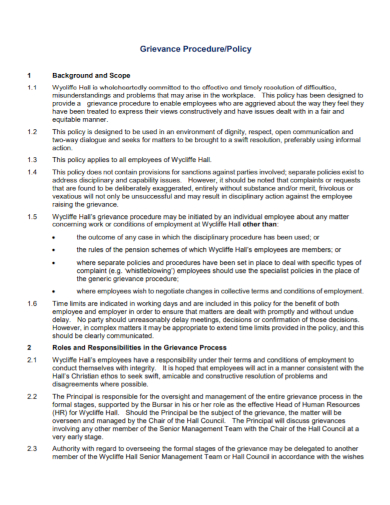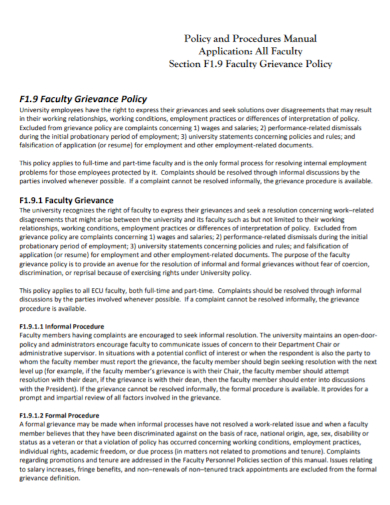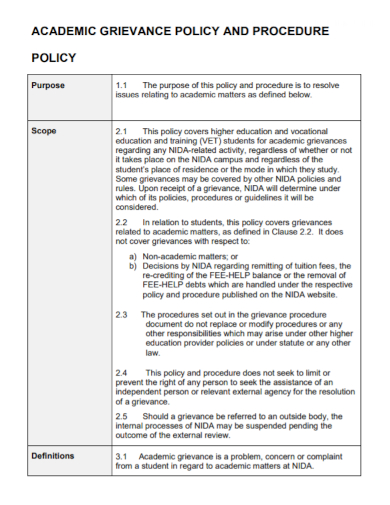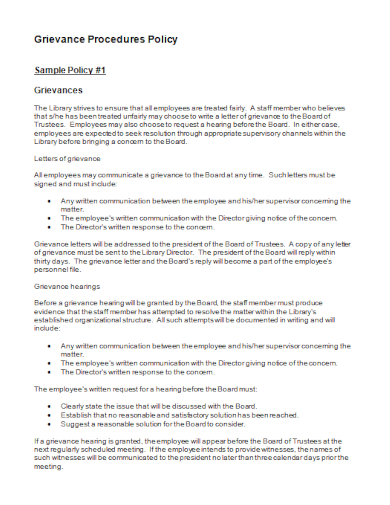Situations that cause misunderstanding in the workplace is inevitable. Conflict and disagreements cannot be avoided, it can happen from simple personality clash or due to an employee’s actions, speech, or habits that may irritate a coworker. Workplace conflict is a big problem for business because it can cause productivity to plummet and absences to rise. There are two types of workplace conflict: when people’s ideas, decisions, or behaviors directly related to their jobs are in conflict, and when two people simply don’t get along. Thus, it’s crucial to set policies in wherein employees can safely complain their grievances to management. In this article, we provide you with free and ready-to-use samples of Grievance Procedure Policies to help you establish such in your company. Keep on reading to find out more!
10+ Grievance Procedure Policy Samples
1. Grievance Procedure Company Policy
2. Grievance Procedure Policy
3. Global Grievance Procedure Policy
4. Sample Grievance Procedure Policy
5. Client Grievance Procedure Policy
6. Grievance Procedure Policy Statement
7. Standard Grievance Procedure Policy
8. Staff Grievance Procedure Policy
9. Faculty Grievance Procedure Policy
10. Academic Grievance Procedure Policy
11. Editable Grievance Procedure Policy
What Is a Grievance Procedure Policy?
A grievance procedure is a structured system for an employee to inform their employer of an issue or concern. If the employee believes that expressing the issue informally has not yielded results, they can file a formal grievance. They don’t want it to be handled casually. As such, a grievance procedure policy lays out a company’s protocols and guidelines for registering a formal complaint about a workplace, employment, or coworker conflict or issue. Businesses develop a grievance procedure policy to assist in the constructive and fair resolution of employee problems.
The three types of grievance procedures
- Individual: When one employee files a complaint regarding management or coworker(s) who have directly impacted the complainant’s health and safety, as well as their capacity to execute job obligations, due to policy violations.
- Group: When a group of employees lodges a grievance against management’s actions or processes that have harmed their health and safety, as well as their capacity to work successfully.
- Union: When filing an individual or collective complaint, employees have the option of including their respective union representatives. In certain circumstances, a union will file a complaint alleging policy violations, contract violations, and/or unfair management practices.
How to Make a Grievance Procedure Policy
Aside from the variety of free Grievance Procedure Policy templates provided above, you can also try make one of your own from scratch. If you’re interested in making a policy personalized to your own workforce, here are some basic components you should consider to guide you in making your own:
1. Set the grievance’s definition and provisions.
Define what the meaning of such grievance. This can be an employee’s complaint, difficulty, or concern about their workplace, job, or coworker relationships.
2. Establish the reasons or cause of such grievances.
Employees may register a grievance for any of the reasons listed below. It could be due to workplace harassment, health and safety, supervisory behavior, or other factors. Changes in employment conditions that are unfavorable. Take note, this is not an exhaustive list. Employees should, however, strive to resolve minor matters informally before filing a formal grievance.
3.Create a mechanism for reporting complaints.
Ensure that employees who wish to file a grievance have access to the appropriate channels. They should contact their immediate supervisor or the Human Resource department. Fill out a grievance form in which you outline the situation, and make sure they have the right to dispute any formal judgment.
4. Adopt a policy of non-retaliation.
When employees submit grievances with the company or external agencies, follow the company’s no-retaliation policy. Finally, the company must treat all employees who file grievances fairly by stressing confidentiality throughout the process and resolving all concerns as quickly as feasible.
FAQs
What are the benefits of the grievance procedure?
Prevents minor conflicts or concerns from turning into something more serious. Encourages you to design very specified corporate policies and employee contracts with explicit expectations. Assists in the development of a company culture of transparency, openness, and trust.
What happens after you file a complaint?
You’ll have a meeting to discuss the matter after you’ve filed your complaint. If you disagree with your employer’s decision, you can file an appeal. Mediation can also aid in the resolution of a problem, and it can occur at any point during the conflict.
What are the main purposes of the grievance procedure?
The grievance procedure has four primary roles: a compliance role; a judicial and adjudicative role; an administrative role; and a ‘fractional bargaining’ role.
It’s critical that employees believe their complaints are addressed seriously. As a result, by implementing a grievances policy, you can ensure that fair methods for dealing with employee issues are in place, as well as mechanisms for collecting and documenting when the same grievances keep cropping up. To help you with, download our customizable and printable Grievance Procedure Policy today!
Related Posts
FREE 10+ Sample Resolution Agreement
FREE 10+ Civilian Complaint Form Samples
FREE 9+ Workplace Investigation Samples
FREE 8+ Workplace Investigation Report Samples
FREE 7+ Sample Customer Complaint Form
FREE 6+ Sample Layoff Notice
FREE 6+ Sample Civil Complaint Forms
FREE 5+ Tax Assessment Samples
FREE 119+ Letter Samples
FREE 82+ Sample Letter
FREE 43+ Examples of Formal Letter
FREE 21+ Work Letter Samples
FREE 14+ Tally Sheet Samples
Sample Termination Letter for the Workplace
FREE 10+ Student & Parent Handbook Samples

